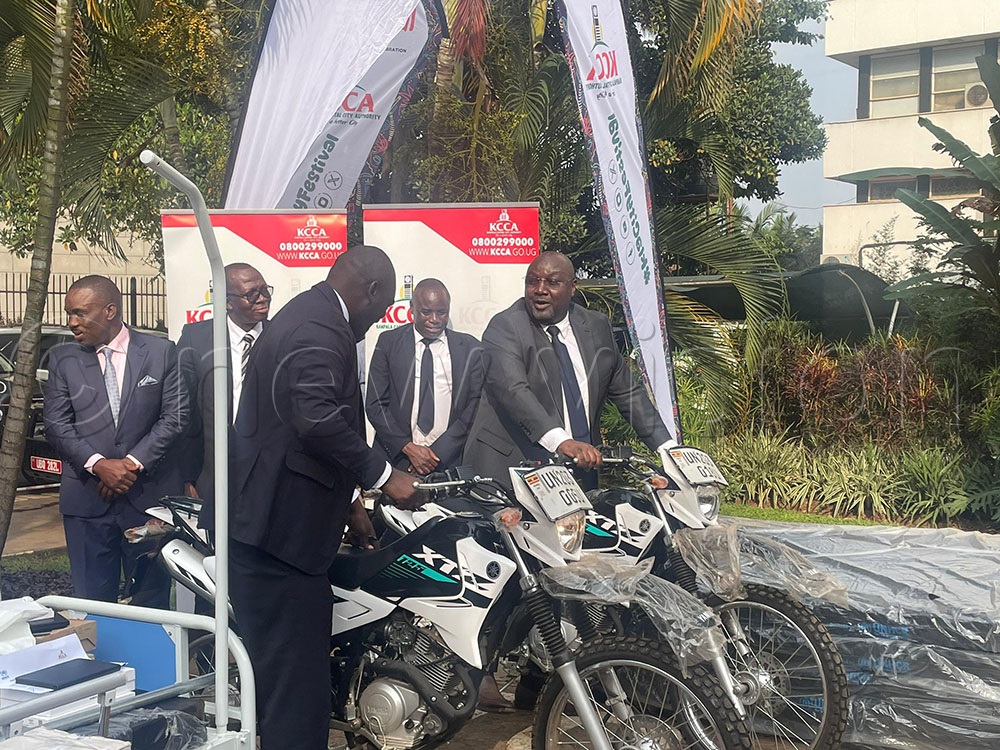Refugee influx: Lukwago says city in state of bother over resource constraints
Kampala Lord Mayor Erias Lukwago, while receiving donations from the UNHCR team on Thursday, August 14, 2025, at the city authority (KCCA) headquarters, expressed deep concern about the growing tensions between host communities and urban refugees.
KKCA ED Buzeki, Doreen Nyanjura, the deputy Lord mayor and Lukwago receiving a computer, one of the donations from the UNHCR representative. (Credit: Ibrahim Ruhweza)
By Ibrahim Ruhweza
Journalists @New Vision
KAMPALA - You could be forgiven for thinking you were in Asmara, the capital of Eritrea, but this is Makindye Division in the heart of Kampala, Uganda.
It’s here that a growing community of Eritreans, Ethiopians, Somalis, Congolese, and South Sudanese, commonly referred to as the Habesha, has found refuge.
Fleeing years of political instability and economic hardship, many of these migrants have made Uganda their new home, drawn by its welcoming refugee policies and relative peace.
Take a walk along the Ggaba stretch any evening, and the changing demographic is impossible to miss. Among every ten people you meet, at least six are likely to be from the Habesha community. Shop signs and business billboards in the Tigrinya language line the roads, and vibrant new businesses have emerged catering to this growing population.
According to the United Nations refugee agency UNHCR, Uganda currently hosts over 1.93 million refugees, making it the largest refugee-hosting country in Africa. Of these, more than 160,000 (8%) live in urban centres, primarily Kampala.
But this refugee influx is beginning to strain the city’s resources, raising concerns among local leaders and residents alike.
Kampala Lord Mayor Erias Lukwago, while receiving donations from the UNHCR team on Thursday, August 14, 2025, at the city authority (KCCA) headquarters, expressed deep concern about the growing tensions between host communities and urban refugees.
“Kampala’s population is rapidly increasing, and while we welcome those fleeing hardship, the resources meant for locals are overstretched,” he said.
“KCCA never budgeted for the growing number of urban refugees.”
Residents living in neighbourhoods like Ggaba and Kansanga complain that the Government has focused more on protecting urban refugees than attending to the needs of locals.
Many accuse the newcomers, particularly Eritreans, of contributing to inflation and rising rent prices. Landlords are reportedly constructing rental properties specifically targeting refugees, who are perceived to have more money, pricing out residents in the process.
"Many of us are being forced to move to far-flung areas without proper access to water, electricity, or security," said a resident, who preferred anonymity.
"We feel abandoned."
The ticking time bomb
The resentment has already started to show. In Sebuliba Zone, Kansanga, a recent water shortage that lasted three days exposed the underlying tension. When residents turned to the community well, Eritrean refugees were allegedly denied access for two days.
Those who managed to collect water were charged as much as sh1,000 per jerrycan, a fee locals say was imposed out of spite, not necessity.
“This is a ticking time bomb,” Lukwago warned.
Some of the motorbikes that will be used to inspect schools. (Credit: Ibrahim Ruhweza)
“We have seen how xenophobia unfolded in South Africa, where attacks in 2008, 2015, and 2019 left foreign nationals dead and wounded. If we don’t address this urgently, Uganda could face a similar fate.”
Xenophobic violence in South Africa was largely driven by unemployment, poverty and competition for jobs and housing. Many South Africans accused migrants of taking economic opportunities and contributing to crime, leading to violent clashes and looting.
Lukwago fears that unless Uganda balances its humanitarian approach with strategic urban planning, it too could see locals turning against refugees.
Currently, urban refugees in Kampala engage in a range of informal jobs, working in restaurants and bars, as hawkers and bodaboda riders, and in small retail businesses.
These are positions many locals feel should be reserved for Ugandan citizens struggling to find employment.
While most refugees in Uganda are expected to settle in designated camps like Kyangwali and Kiryandongo, many Eritreans and other urban refugees are bypassing these sites and heading straight to Kampala.
Lukwago called this trend “unacceptable,” arguing that the city was never designed to absorb such large numbers of displaced people.
“Uganda has opened its doors to the world, and we are proud of that, but the services schools, hospitals, and sanitation were designed for a different population size. For instance, many refugee children don’t understand English, the primary language of instruction in our schools, making integration even more difficult.”
He urged the Office of the Prime Minister (OPM), UNHCR and other humanitarian organisations to step up with direct support to urban areas.
“KCCA needs a dedicated budget to serve both locals and refugees effectively. No one chooses to be a refugee, but we must make this a manageable situation.”
KCCA executive director Sharifah Buzeki echoed Lukwago’s concerns.
“Kampala’s population is growing with or without the refugee factor,” she said. “We need additional funding to expand services. In this era, no one should be left behind.”
A ray of hope
UNHCR responded to the growing concerns with a donation of essential supplies to Kampala city.
According to UNHCR country representative Matthew Crentsil, the agency delivered items worth shillings 1.24 billion, including hospital beds, medical equipment, school materials, motorcycles, and reusable sanitary items. These supplies are intended to benefit both refugees and host communities.
“This is just the beginning,” Crentsil said. “We are committed to working closely with KCCA to find long-term solutions. Once we finalise better agreements with city authorities, more support will be delivered.”
The gesture was welcomed by KCCA officials and community leaders, but many believe it is just a drop in the ocean.
Unless the refugee situation in Kampala is handled proactively with a focus on shared resources, mutual respect, and targeted aid, the tensions could escalate, and the city’s peace, long celebrated, may be at risk.